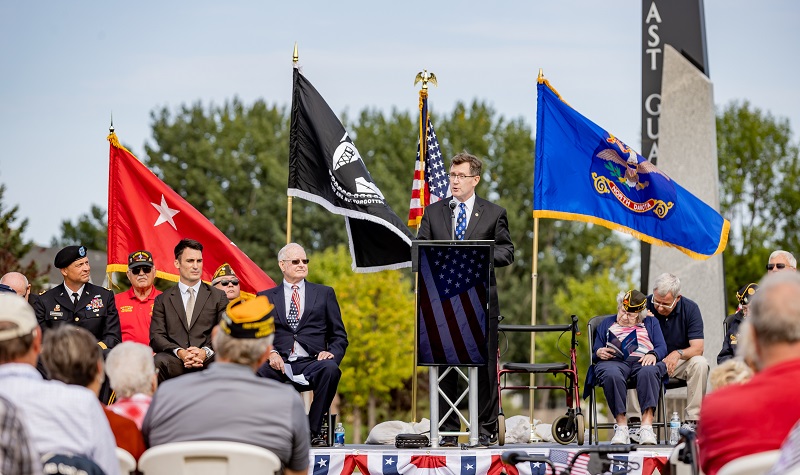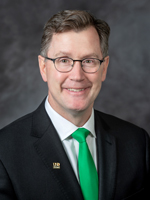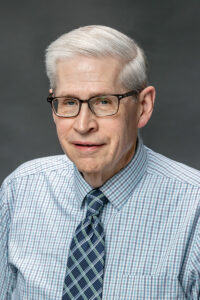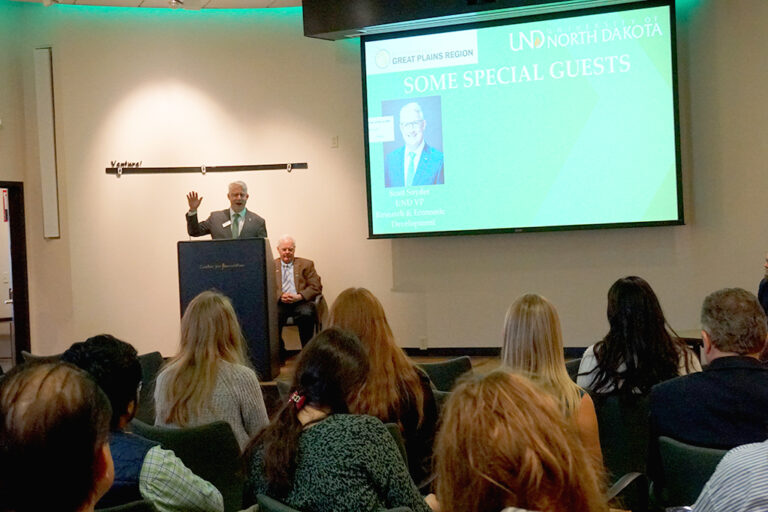The story of Blue Bark 1
At Grand Forks’ new Veterans Memorial Park, UND President Armacost recalls a flight just after Sept. 11 — a flight that brought a fallen servicemember home

Editor’s note: UND President Andy Armacost on Saturday delivered the keynote address during the dedication of the new Veterans Memorial Park in Grand Forks and the ceremony to remember the 20th anniversary of the terrorist attacks that took place on Sept. 11, 2001. Below is an edited transcript of his speech.
* * *
It’s a real thrill for me to be here today. I’m representing a group that hasn’t been represented well – retired military and our veterans that serve our community – who deserve the recognition that this park brings.

I wanted to let you know I was born into a service-oriented family. Today, not everyone is. Places like this provide an important reminder that the freedoms we enjoy as a nation come at a price. They come because of the service of our fellow citizens. They come because of the sacrifice of those who have given their lives in this service.
My call to service began in Air Force ROTC in 1985 and then with my commission in the Air Force in 1989. I’d grown up in a military family. My father served in the Coast Guard, which we sang about today. He was 1964 a graduate of the U.S. Coast Guard Academy. My brother joined the Air Force two years before I did. And so military service was an important part of my family. My wife, Kathy, also grew up in a military family, as her father is a 1964 graduate of the U.S. Air Force Academy. I served 20 of my years of active-duty service at the Air Force Academy, and had many occasions to meet many of my father-in-law’s classmates at their class reunions, which occurred every five years.
The stories of their service were simply incredible. These Vietnam vets gave so much to their nation at a time when the nation didn’t give much in return. Kathy and I were awed at their bravery, their sense of hope and their optimism throughout the war. We met several POWs who logged years in prisons, such as the Hanoi Hilton – some for over six years. Others lost their lives. Kathy’s dad was from the sixth graduating class at the Air Force Academy in 1964, and for one year, he shared the spaces at the Academy with members of the class of 1961.
Eight years ago, I met the son of a 1961 Air Force Academy graduate, Victor J. Apodaca. The son told me this important story about his father. Apodaca was an F-4 pilot in Vietnam, shot down on June 8, 1967, and presumed dead by the end of the Vietnam War. In March of 2001, his remains were positively identified at the facility in Hawaii where they do this type of identification. When this became public, his family and his classmates planned his homecoming to be held at the Air Force Academy in Colorado Springs, September of 2001, at the 40th reunion of the class of 1961.
In September of 2001, the son, whose name is Robert, flew to Hawaii to bring home his father’s remains. The initial flight from Hawaii to Minneapolis was uneventful, having landed at 6 a.m. the morning of September 11, 2001. The attacks later that morning shut down our national airspace, stranding them at the airport. Robert looked across the runway and saw the tails of Air National Guard C-130 aircraft. He reached out to his father’s classmates to see what could be done. They jumped into action, and at 3 a.m. on Thursday morning, Robert and his father were airborne enroute to Colorado Springs on one of those C-130s.
The pilot of that flight informed Robert that at that very moment, there was only one passenger flying in the entire national airspace – and that was him. The flight was named Blue Bark 1, as Blue Bark was the designation during the Vietnam War for flights bringing fallen service members home. Throughout this flight, fighter planes providing necessary air patrols over the airspace of the United States frequently pulled alongside of that C-130’s wing tips to honor the fallen airman and to guarantee safe passage to his final resting place in Colorado Springs at the U.S. Air Force Academy cemetery.
On that Saturday, two days later, Victor Apodaca was honored by his family and his classmates, even though the world around them had changed so drastically earlier in the week.
This story will stick with me for life. It highlights the commitment that we, as a nation, make for our fallen heroes: leave no brother or sister behind.
This incredible new park holds so many such stories and so much importance to our community. It represents each of our service members: those who served during conflicts and those who served during peace; those who have passed and those who are still with us. And I am proud to be a member of this great Grand Forks community, which continues to show its incredible support to our active military members and our veterans, the type of support that other communities could only hope to match.
Furthermore, I am proud to be leading a university that is so committed to the memory of its veterans who have served, and its students – who in the future – will go on to serve with that great legacy. And finally, I’m truly thankful for the efforts of the community members who made this park a reality, for the support of local government, and to those who supported this project with their generous donations. Let’s be sure to continue to honor our veterans on this important 20th anniversary of the attacks at the World Trade Center, the Pentagon and Shanksville, Pennsylvania. We need to reflect upon what happened that day – the souls lost and the lives forever changed.
Thank you.



